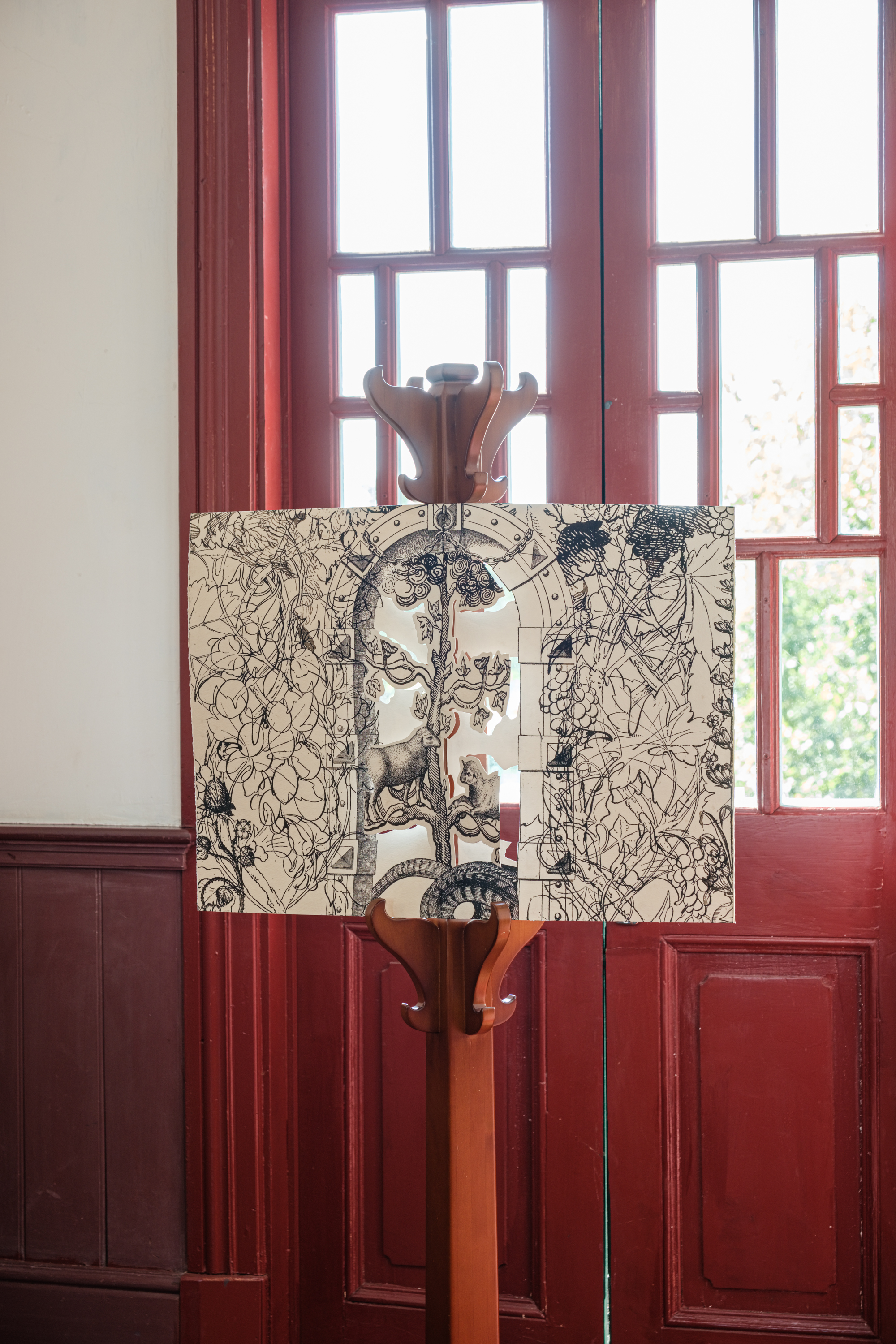- 當代信仰實踐手冊 Practicing Faith Today
- 對神的謬誤 The Fallacy of God
- 煙霧彌漫 Cigarette Papper
- Zygote in US
- TransTerritory
- Looper&HERMIT
- Oops password NO.1-4
-TheSun&Vertical Aerial& A.C&
Dodder
- I need to know the exact size
- 感知範圍 impalpably
- 摩登家庭 Morden Family
- 幸運星 scratch-off lucky
- Wood skin texture
當代信仰實踐手冊 Practicing Faith Today
2021年搬家時,我意外發現了母親收藏的一本書,書名為《當代信仰實踐手冊》。這本手冊由數百篇主題短論組成,內容涵蓋如何在日常生活中應用聖經原則,從靈修、倫理到政治參與,每個面向都附有明確的行動指引與信仰論述。令我震驚的是,書中的許多觀點,正是母親用來教育我的語言——她如何解釋愛、性、罪與婚姻的方式,原來都源自這部手冊。
當我試圖理解宗教與家庭間的深層關係時,也逐漸意識到自己長期對神祕主義圖像的吸引力,似乎也並非偶然。那些圖像經常以劇場式敘事構造出神與人之間的關係,試圖視覺化一種抽象的對話。這樣的圖像語言與手冊中透過見證故事與聖經經文反覆論證神存在的敘述手法,竟然有著相似的邏輯與目的。
我曾以為創作中使用宗教圖像,是為了重新詮釋神與人之間的關係;然而閱讀這本手冊後,我開始意識到,所謂的「關係」本身才是值得追問的核心。或許我從來不需要理解信仰本身,而是透過基督教的語言去理解母親的世界觀,讓我們能夠以更靠近的頻率對話。
我的創作,不再只是揭露或修復某種家庭創傷,而是一種試圖不斷描繪、又不斷模糊的動作——像是用紙、墨與圖像勾勒出與母親的輪廓,也讓「與神的回憶」逐漸轉化為「與母親共享的語言」。
此系列作品將圍繞《當代信仰實踐手冊》中的四個章節主題展開,分別為:〈4. 認識神〉、〈9. 愛的真諦〉、〈19. 在俗世間的基督徒生活〉與〈21. 基督徒與性〉。這四章分別針對神與人的不同關係面向提出論述,從信仰體系到倫理規範,涵蓋信仰的核心概念與其在日常中的實踐方式。
〈4. 認識神〉闡述基督教對於三位一體——聖父、聖子、聖靈——的位格描述,並探討神存在的本質;〈9. 愛的真諦〉與〈21. 基督徒與性〉則聚焦於親密關係中的身心平衡,分別討論靈性需求與肉體慾望之間的張力與倫理界線;〈19. 在俗世間的基督徒生活〉則近似於生活教條,從時間管理、道德規範到行為態度,描繪信徒如何在現實中實踐聖潔生活、並回應神的要求。
我將依據這四章的內容架構進行素材蒐集,來源包括:聖經插圖、宗教文獻、兒童聖經繪本、以及博物館與美術館的開放典藏資料庫。這些視覺素材將透過多種數位工具——如 Photoshop、Illustrator、Procreate、Nomad 等——進行圖像的解構、重組與再製。創作方法上,將以解構原圖像的象徵邏輯為起點,重新排列並介入編碼,使之轉化為探索人與人、人與神之間曖昧關係的視覺語彙。
當我試圖理解宗教與家庭間的深層關係時,也逐漸意識到自己長期對神祕主義圖像的吸引力,似乎也並非偶然。那些圖像經常以劇場式敘事構造出神與人之間的關係,試圖視覺化一種抽象的對話。這樣的圖像語言與手冊中透過見證故事與聖經經文反覆論證神存在的敘述手法,竟然有著相似的邏輯與目的。
我曾以為創作中使用宗教圖像,是為了重新詮釋神與人之間的關係;然而閱讀這本手冊後,我開始意識到,所謂的「關係」本身才是值得追問的核心。或許我從來不需要理解信仰本身,而是透過基督教的語言去理解母親的世界觀,讓我們能夠以更靠近的頻率對話。
我的創作,不再只是揭露或修復某種家庭創傷,而是一種試圖不斷描繪、又不斷模糊的動作——像是用紙、墨與圖像勾勒出與母親的輪廓,也讓「與神的回憶」逐漸轉化為「與母親共享的語言」。
此系列作品將圍繞《當代信仰實踐手冊》中的四個章節主題展開,分別為:〈4. 認識神〉、〈9. 愛的真諦〉、〈19. 在俗世間的基督徒生活〉與〈21. 基督徒與性〉。這四章分別針對神與人的不同關係面向提出論述,從信仰體系到倫理規範,涵蓋信仰的核心概念與其在日常中的實踐方式。
〈4. 認識神〉闡述基督教對於三位一體——聖父、聖子、聖靈——的位格描述,並探討神存在的本質;〈9. 愛的真諦〉與〈21. 基督徒與性〉則聚焦於親密關係中的身心平衡,分別討論靈性需求與肉體慾望之間的張力與倫理界線;〈19. 在俗世間的基督徒生活〉則近似於生活教條,從時間管理、道德規範到行為態度,描繪信徒如何在現實中實踐聖潔生活、並回應神的要求。
我將依據這四章的內容架構進行素材蒐集,來源包括:聖經插圖、宗教文獻、兒童聖經繪本、以及博物館與美術館的開放典藏資料庫。這些視覺素材將透過多種數位工具——如 Photoshop、Illustrator、Procreate、Nomad 等——進行圖像的解構、重組與再製。創作方法上,將以解構原圖像的象徵邏輯為起點,重新排列並介入編碼,使之轉化為探索人與人、人與神之間曖昧關係的視覺語彙。
In 2021, while moving house, I came across a book from my mother’s collection titled Manual for Contemporary Faith Practices. It consists of hundreds of short essays offering practical applications of biblical principles—ranging from spiritual life and ethics to political participation. What surprised me was how many of the perspectives within it echoed the language my mother used in raising me, particularly in how she explained love, sexuality, sin, and marriage.
As I tried to unpack the role religion played in our family, I also began to see why I had long been drawn to mystical religious imagery. These images often stage theatrical relationships between God and humanity, attempting to visualize something abstract and unknowable. This mirrored the structure of the manual, which relies on personal testimonies and scripture to argue for God’s presence—a different medium, but a shared narrative impulse.
I once believed that using religious imagery in my work was about reinterpreting the divine-human relationship. But reading this manual shifted my focus: perhaps the relationship I’m actually investigating isn’t theological, but personal. It’s not about understanding faith itself, but rather about understanding my mother—learning to speak her language through Christianity, so that we might meet on the same emotional frequency.
My work is not about exposing or healing a wound; it’s about continually tracing, and at the same time blurring, the outline of my mother. The memory of God becomes a shared language between us—less about belief, and more about connection.
This series of works is structured around four chapters from the Manual for Contemporary Faith Practices: Chapter 4: Knowing God, Chapter 9: The True Meaning of Love, Chapter 19: Christian Life in the Secular World, and Chapter 21: Christians and Sexuality. Each chapter outlines a different dimension of the relationship between God and people, spanning theological understanding, ethical guidance, and daily spiritual practices.
Chapter 4: Knowing God introduces the Christian doctrine of the Trinity—Father, Son, and Holy Spirit—and discusses the nature of God's existence. Chapters 9 and 21 explore intimacy from both spiritual and physical perspectives, addressing the balance between emotional connection and bodily desire. Chapter 19, meanwhile, reads like a moral guide, detailing how to lead a holy life in secular society, manage one’s time, and meet the expectations of God in
Based on the conceptual structure of these chapters, I will collect visual source materials from religious books, biblical illustrations, children’s Bibles, and open-access museum and archive databases. These found images will be reinterpreted through digital tools such as Photoshop, Illustrator, Procreate, and Nomad. My approach involves deconstructing and reassembling these visual elements to disrupt their original symbolic logic. Through this process, I aim to articulate a visual language that reflects the blurred, abstract, and often ambiguous relationships between humans—and between humans and the divine.
As I tried to unpack the role religion played in our family, I also began to see why I had long been drawn to mystical religious imagery. These images often stage theatrical relationships between God and humanity, attempting to visualize something abstract and unknowable. This mirrored the structure of the manual, which relies on personal testimonies and scripture to argue for God’s presence—a different medium, but a shared narrative impulse.
I once believed that using religious imagery in my work was about reinterpreting the divine-human relationship. But reading this manual shifted my focus: perhaps the relationship I’m actually investigating isn’t theological, but personal. It’s not about understanding faith itself, but rather about understanding my mother—learning to speak her language through Christianity, so that we might meet on the same emotional frequency.
My work is not about exposing or healing a wound; it’s about continually tracing, and at the same time blurring, the outline of my mother. The memory of God becomes a shared language between us—less about belief, and more about connection.
This series of works is structured around four chapters from the Manual for Contemporary Faith Practices: Chapter 4: Knowing God, Chapter 9: The True Meaning of Love, Chapter 19: Christian Life in the Secular World, and Chapter 21: Christians and Sexuality. Each chapter outlines a different dimension of the relationship between God and people, spanning theological understanding, ethical guidance, and daily spiritual practices.
Chapter 4: Knowing God introduces the Christian doctrine of the Trinity—Father, Son, and Holy Spirit—and discusses the nature of God's existence. Chapters 9 and 21 explore intimacy from both spiritual and physical perspectives, addressing the balance between emotional connection and bodily desire. Chapter 19, meanwhile, reads like a moral guide, detailing how to lead a holy life in secular society, manage one’s time, and meet the expectations of God in
Based on the conceptual structure of these chapters, I will collect visual source materials from religious books, biblical illustrations, children’s Bibles, and open-access museum and archive databases. These found images will be reinterpreted through digital tools such as Photoshop, Illustrator, Procreate, and Nomad. My approach involves deconstructing and reassembling these visual elements to disrupt their original symbolic logic. Through this process, I aim to articulate a visual language that reflects the blurred, abstract, and often ambiguous relationships between humans—and between humans and the divine.






